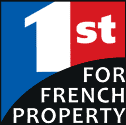Lorraine Property Guide
The Cross of Lorraine has belonged to the region’s heraldic arms for centuries. Local girl Joan of Arc (see our guide to Centre) adopted the cross as her emblem in the struggle against “ze feelthy Eenglish”, who’d come to France in 1337 for an away match and refused to go home. Joan was born in the village of Domrémy in Lorraine. In 1429 Charles VII granted the village tax exemption in gratitude for Joan’s victories. Domrémy’s tax-haven status persisted until the Revolution, whereupon the Inland Revenue sent two bowler-hatted inspectors to demand 364 years’ worth of tax arrears.
The Quiche of Lorraine is a different matter altogether. The word quiche is related to the German ‘Kuchen’, meaning cake, and the true Quiche Lorraine contains no cheese. If you find cheese in yours, then it’s strictly a Quiche Vosgienne, and if you find onions, it’s a Quiche Alsacienne. If you find Spam, send it back. Quiche got a bad name in Bruce Feirstein’s 1982 book ‘Real Men Don’t Eat Quiche’. They eat Freedom Flans. Real men might, conceivably, if they were really hungry, and if they had an impaired sense of smell, eat Lorraine’s other delicacy, Andouille. Andouille is a sausage in which every part of the pig is used, except the grunt. The grunt, meanwhile, as well as the pig’s entire gastrointestinal system, is used in the even-more-hardcore Andouillette. Come and have a go, Mr Feirstein, if you think you’re hard.
Paul Verlaine didn’t eat quiche. He was a symbolist poet and drank Absinthe (see our guide to Provence.) Paul was born in Metz in 1844, led a somewhat colourful life and wrote lots of hippy-trippy poems. The first line of ‘Autumn Song’ – ‘The long sobs of Autumn’s violins…’ was broadcast to the Resistance in the build-up to D-Day. The second line ‘…wound my heart with monotonous langour’ was the signal that invasion was imminent.
Also born in Metz was Raymond Schwartz, a full-time banker and part-time poet and novelist in the invented language of Esperanto. ‘Esperanto’ (in Esperanto) means ‘one who hopes’, and the hope was that the nations of the world could banish misunderstandings and strife if they all spoke the same language. Esperanto is still used today. William Shatner spoke it in the 1965 horror B-movie ‘Incubus’ (see our guide to Brittany.) In 1967, Italian engineer Giorgio Rosa built a 400m² oil-rig-style platform in the Adriatic Sea and declared it an autonomous republic. Rosa was to be President and the language, Esperanto. The Italian government responded by hiring a small boat and sending two policemen and a tax inspector.
Ayatollah Khomeini urged Muslims to learn Esperanto to promote understanding between the faiths. He then discovered that the followers of the Bahá’í Faith had had the same idea, and banned it. Useful phrases in Esperanto include “o falis el la sranko” (something fell out of the cupboard) and ” Homoj tiaj kiel mi ne konadas timon” (Men such as me know no fear.) Esperanto speakers don’t eat quiche.
© 2008 richardheacock @ mac.com
Lorraine Location
Lorraine is the only French region to have borders with three other countries: Belgium, Luxembourg, and Germany. It also bordered by the French regions of Franche-Comté, Alsace, and Champagne-Ardenne. The rivers Rhine, Moselle, Meurthe, and Meuse traverse Lorraine. The departments are Meurthe-et-Moselle, Meuse, Moselle, Vosges.
Lorraine Landscape
This is an industrial area of France and the landscape is rather bleak – dominated either by industry or by the windswept generally flat agricultural plains.
Head towards to the Vosges mountains for some fine views.
Lorraine Attractions
The two main cities Nancy and Metz are attractive.
A few vineyards can be discovered in the region of Lorraine. They are split between two small districts: Côtes de Toul, where 90 percent of the production takes place, and Vins de Moselle in the Moselle Valley. These vineyards are the most northerly vineyards in France but the colder climate makes production difficult.
There is some fine fishing in the lakes and rivers of the region. Sailing, windsurfing and motor boats can be enjoyed on the vast expanses of water at Madine, Gondrexange, Stock and Gérardmer. Canal boating enthusiasts have plenty of waterways to enjoy.
Lorraine Weather
Lorraine is a region to enjoy the seasons. Cold in winter with snow, and night time temperatures below zero! The summers can be hot and sunny. Rainfall is common in all months of the year.
Getting there
By Air
Nearest airport at Strasbourg.
By Train
Good access to Metz and Nancy.
By Car
There are autoroutes to Metz and Nancy.
Lorraine population
2.3 million inhabitants.
Major Towns/Cities
Nancy – is Lorraine’s historic capital, and lies along the Canal du Marne and the Meurthe rive. It is renowned as the most beautiful example of baroque town planning in France.
Metz – Metz was chosen as the capital of the newly created region of Lorraine in the middle of the 20th century. It is located at the confluence of the rivers Moselle and the Seille. It is famous for its yellow limestone architecture and is nicknamed “The Green City” for its exceptional gardens and parks.
Verdun – Verdun was the site of the Battle of Verdun in 1916 during World War I. There are many French and German cemeteries throughout the battlefield. The largest is the French National Cemetery and Douaumont Ossuary, near Fort Douaumont.
Property Prices
Property prices are low (as is the cost of living).
Lorraine Property Selection
Listed below are the departments in the region of Lorraine; the number of properties in each department are denoted in brackets - click on a department to see the properties available.All the properties in Lorraine by department.
(Number in brackets = number of properties)
Vosges Property (1)
